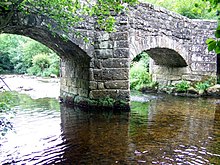Fingle Bridge

Fingle Bridge is a 17th century stone arch bridge that spans an unclassified road over the River Teign . It is located at Drewsteignton , within Dartmoor National Park in Devon , England . The former packhorse bridge has three arches, and the two middle pillars of the bridge are reinforced by wedge-shaped icebreakers on the upstream side, which form a pass for pedestrians on the bridge. The building is a Grade II * listed building .
history
The name of the Fingle Bridge comes from Fingle Brook , a small tributary of the River Teign in the immediate vicinity of the bridge. Fingle is derived from the Old English word “fang”, in German “catch” and indicates the suitability of the tributary for fishing.
The bridge sits at the bottom of the Teign Gorge, between the old ramparts above the river; Prestonbury Castle, north of the river, is 130 m, and Cranbrook Castle, on the south side, is 230 m above the valley floor. The bridge was built on the historic connecting route between the two castles. In its early years, the bridge was an important crossing over the river and was used by pack horses to carry grain and wood across the gorge. The way up to Cranbrook Castle is just a no longer maintained byway, so the bridge only leads to a parking lot. The actual function of the bridge was replaced by the larger and more easily accessible Dogmarsh Bridge, on the A382 road further upstream.
The arches of the bridge were repaired in the 19th century , according to historians at English Heritage .
In 1897, Jesse Ashplant founded the Fingle Bridge Tea Shelter on the northern bridgehead, which served fishermen, travelers and carters. This later became the Anglers' Rest pub , which was later renamed the Fingle Bridge Inn.
In 1955 Fingle Bridge was classified as Grade II, in 1967 the structure was reclassified to Grade II *.
Surroundings
There was once a mill about 200 m downstream, Fingle Mill, which according to records had been grinding grain as early as 1790. It was operated by George Ponsford, who also owned the bridge; The water mill was driven by a 500 m long mill stream .
There is a dartmoor cross on the way south to Cranbrook Castle ; these are stone slabs made of granite that are carved in a cross shape.
supporting documents
- ^ Dartmoor at its very best . Plymouth Herald. July 28, 2012. Archived from the original on May 5, 2013. Info: The archive link was automatically inserted and not yet checked. Please check the original and archive link according to the instructions and then remove this notice. Retrieved March 3, 2013.
- ↑ a b Great Britain, Ordnance Survey (ed.): Outdoor Leisure 28 - Dartmoor . Southampton 1995.
- ↑ The Rocky Teign Gorge to Fingle Bridge . The Automobile Association . Retrieved February 16, 2013.
- ↑ Walk 35 The Two Moors Way, the Teign Gorge and Some Special Moor Stones (PDF) Devon County Council. Retrieved March 2, 2013.
- ^ A b Maurice Daniel: Fingle Bridge Cross . Dartmoor-crosses.org. November 4, 2001. Retrieved March 2, 2013.
- ↑ Devon's rivers: The Teign . BBC. February 6, 2008. Retrieved March 3, 2013.
- ^ A b Fingle Bridge, Moretonhampstead . BritishListedBuildings.co.uk. Retrieved March 2, 2013.
- ^ History of Fingle Bridge ( Memento January 11, 2011 in the Internet Archive ) finglebridgeinn.com.
- ^ Fingle Bridge, Drewsteignton . BritishListedBuildings.co.uk. Retrieved March 4, 2013.
- ↑ FINGLE . Moretonhampstead History Society. February 19, 2013. Retrieved March 3, 2013.
Coordinates: 50 ° 41 ′ 43.8 " N , 3 ° 46 ′ 51.6" W.
